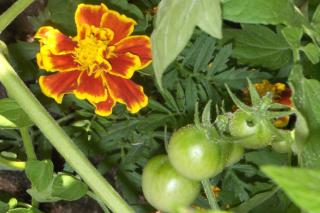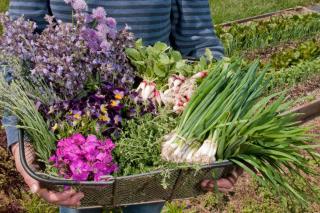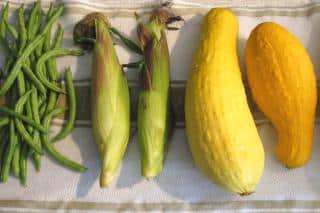

When plants live as neighbors, they’re just like us: often, they really help each other out, but sometimes they just can’t stand each other! Check this list of how to pair vegetables to make sure relationships in your vegetable patch are worthy of Mr Roger’s neighborhood! That’s the art of companion planting.
Read also:
Companion planting, or associating plants, means growing several different species of plants in the same place at the same time. This technique is part of a wider gardening concept called permaculture.
It’s an alternative to how farmers of the past few generations have been growing things. The aim is to respect the environment while still producing excellent produce that is healthy for us to eat.
 Pesticides don’t have a say here at all, of course! Companion planting comes as a very precious help to get rid of chemical pesticides. Some plants are indeed capable of repelling pests, and others help prevent the spread of diseases. Furthermore, many plants actually enrich the soil they grow on: perfect to fuel other nutrient-hungry vegetables!
Pesticides don’t have a say here at all, of course! Companion planting comes as a very precious help to get rid of chemical pesticides. Some plants are indeed capable of repelling pests, and others help prevent the spread of diseases. Furthermore, many plants actually enrich the soil they grow on: perfect to fuel other nutrient-hungry vegetables!
 The allelopathic phenomenon: This is the sum of beneficial and detrimental effects of plants on each other.
The allelopathic phenomenon: This is the sum of beneficial and detrimental effects of plants on each other. Definitely one of the most famous companion plant combinations! The Aztecs pioneered this technique in the Americas. It pairs together corn, beans, and squash (originally the Cucurbita maxima species).
Definitely one of the most famous companion plant combinations! The Aztecs pioneered this technique in the Americas. It pairs together corn, beans, and squash (originally the Cucurbita maxima species).
This brilliant combination takes the advantages of each plant and merges them together on the same plot of soil.
Here is a list of companion plants, and also a list of those that shouldn’t be planted near each other. Of course, these are only the most common combinations. There are many more to discover and experiment with.
These include the most common vegetables, herbs and flowers
| Plant | Favorable companion plants | Detrimental companion plants |
| Garlic | Peach tree, apple tree, pear tree, plum tree, chicory, Jerusalem artichoke, tomato, strawberry, raspberry, rose tree | Cabbage, potato, bean, pea, cabbage, artichoke, asparagus, marigold |
| Artichoke | Cabbage, lettuce, spinach, parsley, nasturtium | Garlic |
| Asparagus | Potato, cucumber, pickle, parsley, leek, pea, squash, basil, nasturtium, tomato | Mint, red beet, chard, chicory, onion, garlic, chives |
| Eggplant | Marigold | Potato |
| Basil | Tomato, chili, cucumber, pickle, squash, cantaloupe, cabbage, broad bean, zucchini, fennel, asparagus | Rue, absinthe |
| Chard (or Swiss chard) | Supposedly, this plant doesn’t make for good companion planting, but it’s still worth testing in your vegetable patch. | |
| Red beet | Lettuce, celery, coriander, parsnip | Tomato, asparagus, spinach, leek |
| Nasturtium | Apple tree, radish, broccoli, bean, artichoke | |
| Cardoon | Pair this one with short lead time crops such as radish or lettuce by sowing them at the same time. | |
| Carrot | Leek, garlic, onion, shallot, chives, red beet, pea, radish, lettuce, arugula, parsnip, tomato, bean, salsify, chili | Dill, corn, chard |
| Celery | Leek, cabbage | Corn, parsley, lettuce |
| Chicory, curly endive and escarole | Spinach, arugula, marigold | Brussels sprouts, asparagus, turnip |
| Cabbage | Dill, celery, bean, mustard, rosemary, tomato, absinthe, cosmos, medicinal sage, thyme, bean, lettuce, spinach, marigold, nasturtium | escarole, zucchini, watercress, fennel, corn salad, corn, radish, leek, strawberry, oregano, chili |
| Chives | Carrot, apple tree, peach tree, red currant, black currant, rose tree, strawberry, cucumber, squash | Asparagus, radish, bean |
| Cucumber and pickle | Bean, corn, pea, asparagus, celery, cabbage | Fennel, leek, lettuce, escarole, melon, turnip |
| Squash | Corn, bean, asparagus, celery, cabbage, lettuce, corn salad, pea, onion, basil, chives, coriander, oregano, nasturtium | Radish, fennel |
| Zucchini | Basil, nasturtium | Cauliflower, radish, cucumber |
| Shallot | Carrot | Bean, pea |
| Spinach | Cabbage, rose tree, artichoke, chicory, strawberry, bean, turnip, salsify, radish | Jerusalem artichoke, sunflower, red beet, chard, fennel |
| Fennel | Knob celery (or celeriac), leek, basil | Tomato, absinthe, cucumber, chili, spinach, bean, pattypan squash, marigold, turnip, cabbage, coriander |
| Broad bean | Cabbage, potato, corn, lettuce, savory, basil | Onion |
| Strawberry | Leek, garlic, chives, onion, peach tree, spinach, lettuce, corn salad, turnip, bean | Cabbage |
| Bean | Corn, pumpkin, melon, watermelon, carrot, celery, cabbage, cucumber, potato, spinach, lettuce | Leek, garlic, shallot, onion, chives, fennel, pea, zucchini |
| Lettuce | Cabbage, carrot, onion, cardoon, pea, red beet, squash, broad bean, strawberry, melon, bean, turnip, leek, artichoke | Cucumber |
| Corn | Red beet, bean, pea, pumpkins and squash | Lettuce, onion |
| Melon | Watermelon | |
| Turnip | Wild chicory, spinach, strawberry | Curly endive, escarole, savory, fennel |
| Onion | Carrot, lettuce, corn salad, radish | Bean, pea |
| Parsnip | Radish, red beet, kohlrabi, white onion | Lettuce |
| Watermelon | Melon, bean, tomato, cabbage | |
| Sweet potato | Bell pepper, chili | |
| Chili | Basil, carrot, marjoram, oregano | Fennel, kohlrabi, sweet potato |
| Leek | Carrot, celery, strawberry, asparagus, lettuce, corn salad, tomato, fennel, artichoke | Chard, red beet, cabbage, bean, parsley, pea |
| Pea | Potato, coriander | Onion, garlic, shallot, leek, parsley |
| Chick pea | Corn, squash (Cucurbita pepo) | |
| Bell pepper | Onion (to be checked) | Solanaceae (nightshade family) |
| Potato | Asparagus, German chamomile, nasturtium, celery, Brussels sprouts, head cabbage, garlic chives, coriander, broad bean, bean, pea, radish, marigold | Walnut, sunflower |
| Squash (especially the Cucurbita maxima family) | Corn, bean | |
| Radish | Watercress, chervil, parsnip, carrot, pea, cucumber, pickle, spinach, bean, kohlrabi, potato, tomato, onion | Chives, cabbage |
| Arugula | Red beet, carrot, curly endive and escarole | |
| Tomato | Mexican marigold, French marigold, cosmos, German chamomile, cabbage, geranium, watermelon, cucumber | Potato, sunflower |
| Jerusalem artichoke | Should mostly be planted on its own |
Blending flowers, shrubs and vegetables together in growing beds is a great way to observe how nature works.
And it’s beautiful, too!